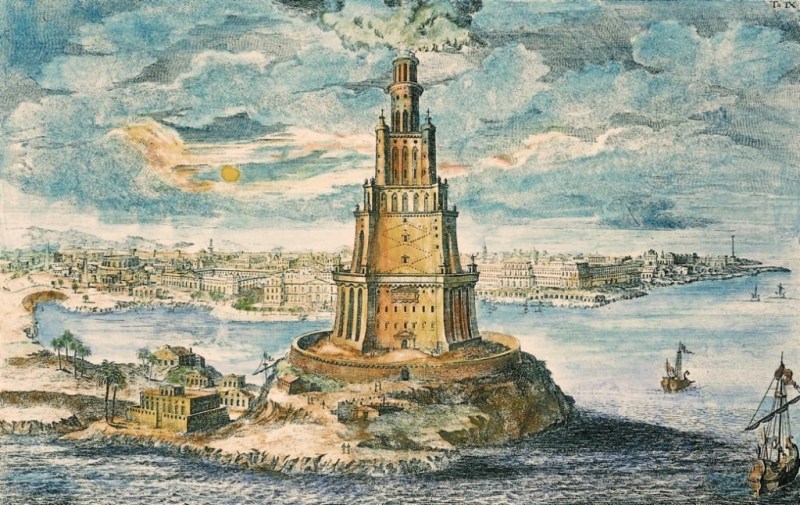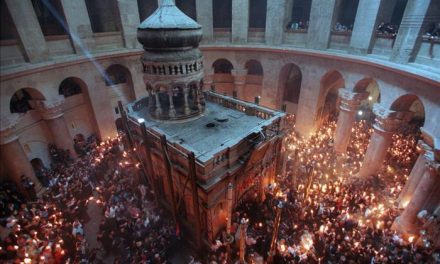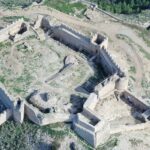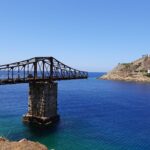Linked with myths and legends across time, lighthouses have always been more than just operational Aids to Navigation. Often made of stone and built on inaccessible coastlines on islands or capes these sea signposts are part of a country’s cultural heritage and, when it comes to Greece and its seafaring nation, they are definitely part of its maritime tradition. Providing visible warnings against shipping hazards, such as rocks or reefs, lighthouses represent at the same a sign of hope, safety and protection for those sailing.
Engraving, imagining the Lighthouse (Pharos) of Alexandria (Egypt). From the book Entwurf einer historischen Architektur by Johann Bernhard Fischer von Erlach via Wikimedia Commons)
The first lighthouses appeared in antiquity and they were placed on a platform on hilltops functioning more as an entrance marker to ports than as warning signals for reefs and promontories as it is the case nowadays. In Greek antiquity such references are first met in Homer’s epic poems describing the lighting of torches on the top of hills or towers. The most famous lighthouse structure of ancient times is Pharos of Alexandria in Egypt. It was constructed on the island of Pharos in the harbor of Alexandria in 280 BCE and its light could be seen over 40 kilometers away. Pharos, which is considered as one of the Seven Wonders of the World, as it was a technological triumph becoming the archetype of all lighthouses since, collapsed following a series of earthquakes between 956 and 1323.
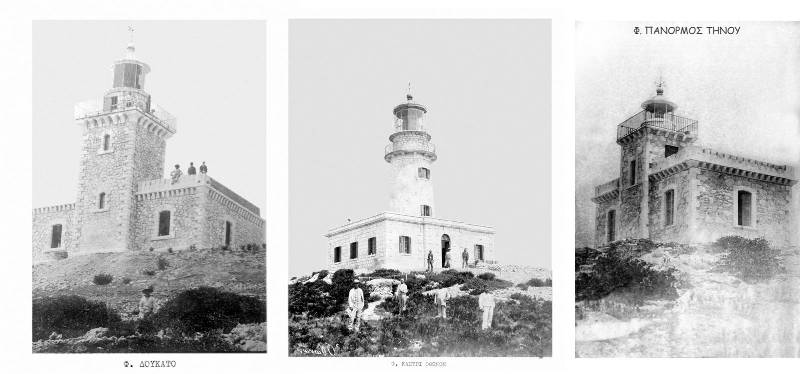
Historic pictures of lighthouses in the Greek islands (19th, 20th century). Dukato in Lefkada, Kastri in Othoni, Panormos in Tinos. © Hellenic Navy’s Lighthouse Service website (HNLS)
In Greek waters, according to historical sources, lighthouse structures have spotted the Aegean archipelago since the 15th century in the ports of Chios (1420), Rhodes (1490), Mytilene (1782) et al. The first one that was built under the modern Greek state was at the port of Aegina in 1829, when the city was declared the capital of the Greek state. The lighthouse network soon expanded in the rest of the Greek territory, its operation and conservation being assigned to the Hellenic Navy’s Lighthouse Service established in 1887.
In Greece there are currently more than 1,000 of them around the country’s 15,000-kilometer coastline -mostly automatically illuminated- while 58 are still monitored by lighthouse keepers. The most impressive among them are stone-made lighthouses of significant architectural and cultural value, constructed mostly in the late 19th and early 20th century. A large number of them were damaged or destroyed during World War II counting nowadays 144 stone lighthouses, of which 46 have been listed as Protected Historical Monuments by the Ministry of Culture.

Lighthouse Tourlitis in Andros (© HNLS), Akrotiri in Santorini (© iStock / Getty Images Plus), Chania in Crete (© HNLS)
Greece features one of the greatest lighthouse networks in the world with stunning monuments dominating the coasts and offering breathtaking views. From “Kastri” lighthouse on the island Othoni in the Ionian Sea in the northwest of the country to the southernmost lighthouse on the small island of Gavdos, these particular buildings fascinate with their charm. Among the most impressive are Dana Lighthouse (1870) dominating the entrance of Poros bay, Zourva Lighthouse (1883) in Hydra, destroyed in World War II and re-built in 1946, Tourlitis (1887) in Andros, Disvato (1903) in a deserted islet between Andros and Tinos Island, Melagavi (1897) in Loutraki, Akrotiri (1892) in Santorini island, or the lighthouse in Chania built during the Venetian occupation around the late 16th century and rebuilt between 1824 and 1832 during the Turkish occupation.
In the Peloponnese there are two imposing stone lighthouses situated in the breathtaking Capes Tainaron and Maleas carrying many horror stories and legends. Cape Tainaro, was considered in the ancient world one of the gates to Hades, to the Underworld. This fierceful location was of spiritual significance to the Spartans, who built there the Sanctuary of Poseidon Tainarios. During the Frankish Occupation of the Peloponnese in the 13th – 14th century the Cape was renamed into Cape Matapias, name which still exists in many nautical maps. The lighthouse that was constructed in 1882 offers an astonishing view of the Bay of Laconia and Mani Peninsula.
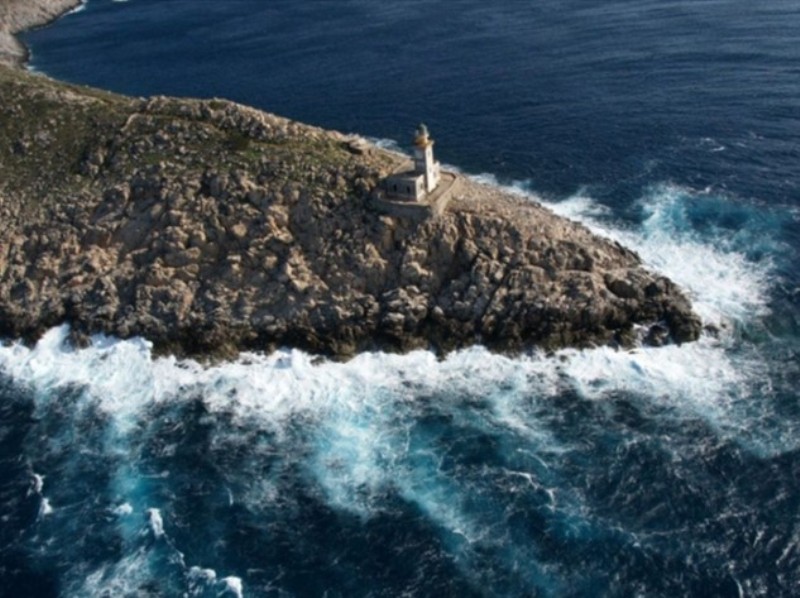
Lighthouse Tainaro, at the southern tip of the Peloponnese (© Hellenic Navy’s Lighthouse Service)
Cape Maleas in the southern end of the Peloponnese -with seas around being notoriously treacherous and difficult to navigate- is known from the ancient times as one of the major routes for crossing the northeast Mediterranean to the west. The difficult weather around the cape was notorious at the time as well, as it is described in the Odyssey. The ancient Greek writer Stravon wrote of the place’s dangers: “If you decide to cross Maleas, forget that you have a family”. Maleas stone lighthouse constructed in 1883 was considered very important for the safety of passing boats as many ships were wrecked in their attempt to pass the Cape that was given the nickname Xylochaftis, from the Greek words for ‘wood’ and ‘gobble up.’

Spathi in Serifos, Arkitsa in the Evoikos Gulf, Dana in Poros (© Hellenic Navy’s Lighthouse Service)
Most of the lighthouses in Greece in the 19th and 20th century have been constructed by the French Lighthouse Company with the exception of the Ionian islands where lighthouses in Corfu, Kefalonia, Zante, Strofades and Paxoi were built during the British rule from 1815 to 1864. The Agii Theodoroi lighthouse in Kefalonia is the most distinctive of all lighthouses in Greece as it has a circular colonnade structure with 20 simple Doric columns. It was destroyed by the earthquake of 1953 and rebuilt in 1960 according to its original architectural design.
Agii Theodoroi in Kefalonia (© iStock / Getty Images Plus)
Lighthouses in Greece are nowadays operated by electric and solar power collected through photovoltaic systems replacing acetylene gas or diesel power lamps of the past. The lighthouse network is maintained by the Hellenic Navy’s Lighthouse Service but the restoration of stone structures is a costly and difficult task taking into consideration the rugged locations where lighthouses are built. Apart from public and European funding used to restore stone lighthouses, private initiatives have also been used. The Aikaterini Laskaridis Foundation decided in 2008 to restore and renovate the stone-built lighthouses of Capes Tainaron and Maleas and the Dana lighthouse of Poros island as the preservation of Greece’s cultural and maritime heritage is among its basic purposes.
Visits to the stone lighthouses in Greece are possible only with a special permit issued by the Hellenic Navy’s Lighthouse Service.
Read more via Greek News Agenda: Lighthouses in Greece
I.E.

